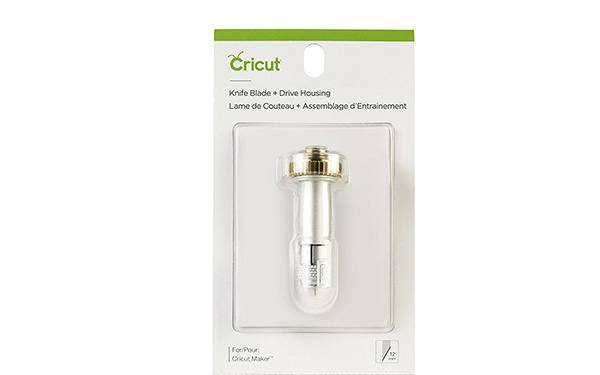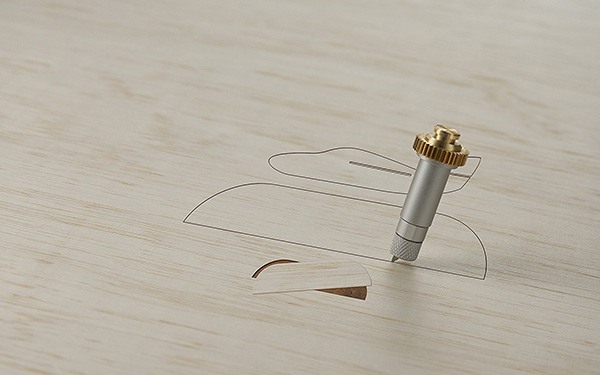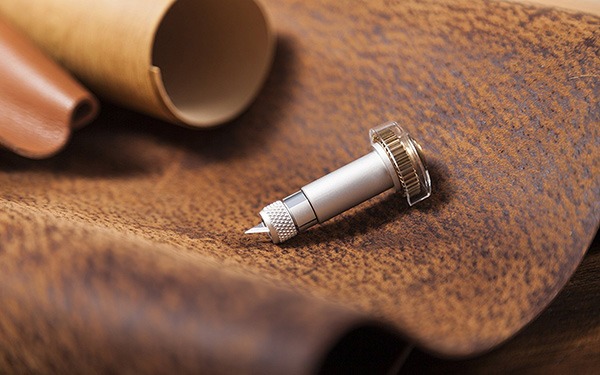We’ve been waiting for it for months now… introducing the Cricut Maker Knife Blade (available to buy on Amazon)!
This revolutionary blade has been made exclusively for the Cricut Maker cutting machine.
We’ll be delving into everything you need to know about this exciting tool, but suffice to say that it’s been designed for extra deep cuts.
Fancy cutting some balsa wood? The Knife Blade should be on your shopping list.
Let’s find out more…
Post Contents
What is the Cricut Maker Knife Blade?
Unless you’ve been hiding under a rock for the past ten months, you’ve likely heard about the Cricut Maker machine.
As the name suggests, this cutting machine is for makers — not just people who love cutting. Sewists, in particular, love this machine being as it comes with an awesome rotary blade that can cut through any fabric, and access to hundreds of different sewing patterns.
The Knife Blade, on the other hand, has been in development for the past ten months so we don’t know quite as much about it.
It was finally released on May 1st, 2018.
Here’s what you need to know…
Cricut Knife Blade Facts
- Purpose: For cutting through extra thick materials
- Materials: Balsa wood, matboard, chipboard, leather, craft foam, and basswood. See the full list here
- Material thickness: Up to 3/32 inches or 2.4mm
- Compatible machines: Cricut Maker
- Housing required?: Yes
Here’s Melody Lane introducing it for us:
How Does It Work?
The Knife Blade is a little different than Cricut’s other blades and is actually more akin to an X-Acto Knife.
Essentially, it will make multiple passes on thick materials, gradually increasing the pressure until it manages to complete the cut.
This means that you don’t adjust the cut settings of the blade beforehand, but rather it adjusts automatically according to the material it’s working on.
This is different to most blades where you will set the cut settings yourself and the blade will make a few passes at that exact configuration. The Knife Blade is more intuitive.
How to Use the Cricut Maker Knife Blade
The Knife Blade isn’t like all the other blades in your storage — you will need to specially prepare your machine and materials to get the best use out of it.
Firstly, you can only use it on materials up to 11 inches wide so be sure to trim your material if it is slightly over this.
Take that material and make sure that it lines up with the top left corner of the sticky part of your cutting mat.
Cricut recommend that you use the StrongGrip Cutting Mat for most Knife Blade materials, except for Craft Foam which should be used with a standard mat.
Next, use some transfer tape to affix the material to the mat on all four sides to prevent it slipping during the cutting process.
Finally, you’ll need to move the white star wheels on the roller bar of the Maker to the far right of the bar. This will give some extra clearance for the thicker material and will stop them leaving any unsightly marks on it. You will need to gently move the carriage and use a little pressure on the wheels to move them effectively.
Make sure that you complete these steps while the machine is still in OFF mode.
You can turn it on once you’ve completed these steps.
In Cricut Design Space
First things first, we should note that Cricut haven’t yet added the Knife Blade functionality to the Design Space mobile app yet so you’ll have to have access to your laptop when using this tool.
Also, there’s no possible to edit the cut settings for the Knife Blade.
This is because the blade is primed to use multiple passes along each cut path and will automatically adjust its own pressure settings until the material is fully cut.
When you’re creating your design, make sure to leave around 0.25 inches between the edges of your design and the edge of the material. The blade is more likely to break if it is taken off the edge of the material, so be conservative with spacing.
Once the design is ready to go, select the material you’ll be using and tick that you’ll be using the Knife Blade.
When It’s Finished…
At some point, the Knife Blade will stop making passes and the cut will come to an end.
At this point, you have the option of ‘adding a pass’ if you think the Knife Blade hasn’t completely cut through the material at any point.
Leaving the cutting mat in the machine, double check whether all cuts have been successfully made.
If they haven’t, click the GO button again on the front of the machine to initiate the next pass. Bear in mind that the pressure increases every time you use the Knife Blade on one design so make sure that you don’t do this too many times and end up shredding your mat to bits!
Once the cuts have been successfully completed, you should remove the cutting mat from the Maker and remove the tape that was affixing the edges of the material to the mat.
You can now go ahead and weed the material. All done!
Replacing the Knife Blade
As you might expect with a blade for thicker materials, the Knife Blade is liable to wear down quicker than normal, everyday blades, so you will probably need to replace it at some point.
You can buy Knife Blade replacements easily, and as these are separate from the housing, are considerably cheaper to buy the second time around.
Here’s how to replace the Cricut Knife Blade:
- Remove the Knife Blade housing from the Cricut Maker carriage
- Using the Safety Change Cap that comes with the replacement Knife Blade, cover the blade and sleeve within the housing
- Twist the Safety Change Cap until the sleeve is completely unscrewed and detached from the housing
- Carefully turn the housing over, allowing the blade to drop out
- Carefully dispose of the blade
- Taking the replacement blade, line the groove up with the matching one in the blade housing
- Drop the replacement blade into the housing
- Use the Safety Change Cap again to cover the blade and sleeve
- Twist the cap clockwise until the sleeve is tightly screwed into the blade housing
- Remove the Safety Change Cap
- Add the housing back into the carriage of the Maker
Cricut Maker Knife Blade Review
The Positives
It Allows For Much Deeper Cuts and Thicker Materials
The number one positive of the Cricut Knife Blade is just how many more opportunities it allows you to exploit with the Cricut Maker.
No other hobbyist cutting machine lets you cut such thick materials so well. This is all the more miraculous considering the very reasonable price of the Maker.
This is all alongside everything else that the machine offers — it’s rare to find something that can cut so well on both different types of fabric as well as thicker materials.
So Much More To Make!
Leading on from the first point is how much more stuff you can make with the Maker now you’ve got the Knife Blade.
We’re talking jigsaw puzzles, wooden signs, dioramas, home decorations, leather jewellery, airplane models, foam toys and even wooden dinosaurs!
The world is your oyster with the Cricut Maker Knife Blade.
Can Handle Most Designs
The Knife Blade is definitely a quality piece of machinery, able to cut moderately intricate designs with no problem at all.
It’s not especially fast, but it definitely gets the job done with admirable precision and accuracy.
Be prepared for more intricate designs taking a great deal more time.
Reasonably Priced
While the Cricut Maker is the most expensive machine in the Cricut line at the moment, the Knife Blade certainly won’t break the bank.
The Knife Blade and Drive Housing is currently priced at $39.99 MSRP while the Knife Blade Replacement Kit is just $16.99 MSRP.
Exclusive to the Cricut Maker
Another thing we love about the Knife Blade is that the only people using it will be other Cricut Maker users.
It’s not compatible with the Explore family of machines as they simply don’t have the power and engineering behind them to support this type of blade.
That means that everything you make with the Knife Blade will be that much rarer and special by warrant of it being such an exclusive tool.
The Negatives
Let’s get one thing clear — we really like the Cricut Maker Knife Blade, but we think it’s important that you know all the potential pros and cons of the product before you buy it.
Here’s a few things worth considering before you put your money down.
It’s Kinda Slow
The Knife Blade is not for making projects on the fly — depending on the intricacy of your design, it may take a long time to deliver the cut you want.
One of our test cuts with the blade ended up taking hours and required a couple of extra passes — although it’s worth noting that this was a pretty intricate design on matboard, so quite a challenge.
You can’t use the blade in Fast Mode either so prepare to buckle up for a long night if you’re doing something similar.
The Knife Blade takes its time to deliver the results you need. This isn’t necessarily a bad thing — just make sure that you have the time before you dive head first into a project.
Bearing in mind the additional time you might need for the Knife Blade, as well as the higher expense of these thicker materials, it’s a good idea to thoroughly plan your project in advance to avoid any wastage.
It Doesn’t Work With The Mobile App Yet
Cricut routinely seem to put their mobile app on the back burner and the Knife Blade is yet another example of that.
Functionality hasn’t been added to the app yet.
Cricut say that this is because they don’t want to put your smartphone out of action for the potentially long time that the Knife Blade might be in use for, but we’re not convinced.
Surely they should be able to reconfigure the app so it works in the background rather than needing it open on your phone for the entire duration of the cut?
Overall Verdict
Overall, we love the Cricut Maker Knife Blade and think it’s a worthy addition to our cutting tool chest.
It’s amazing how many more projects and opportunities are open to us now, and it’s fun to cut with thick materials that have previously been out of bounds to hobbyist cutters.
It’s not perfect — it will take it’s time and there’s no app functionality as of yet — but we think it delivers the goods in admirable fashion.
Check Price on AmazonHave you tried the Cricut Knife Blade yet?



